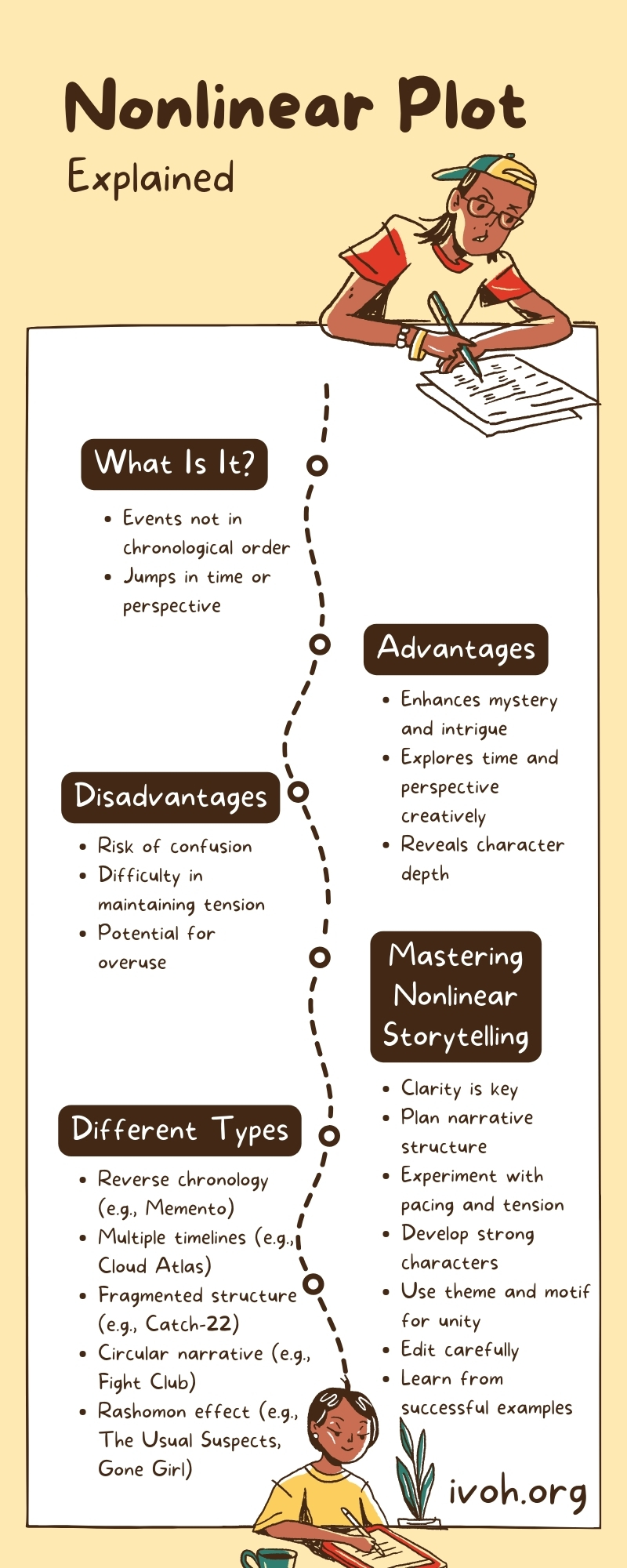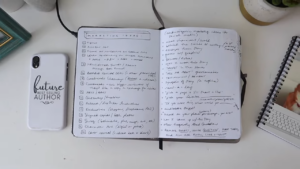If you’re just starting to explore the world of writing, you might have come across the term “nonlinear plot.” This might sound a bit complex, but it’s actually a really interesting way to tell a story.
Unlike traditional stories that follow a straight path from beginning to end, a nonlinear plot mixes things up. It jumps around in time or presents events out of sequence. This can make your story more engaging and give your audience a unique experience as they put the pieces together.
So, if you’re curious about breaking away from the usual storytelling format, learning about nonlinear plots is a great start!

Key Features of A Nonlinear Plot
A nonlinear plot is a narrative structure where events are not presented in chronological order. In other words, the story does not follow a straight line from beginning to end. Instead, it may jump back and forth in time, presenting events out of sequence or from multiple perspectives.
This narrative technique can create a sense of mystery, suspense, and intrigue as the audience works to piece together the full story. Authors like William Faulkner, James Joyce, and Julio Cortázar experimented with nonlinear plots in their works.
In cinema, directors like Quentin Tarantino, Christopher Nolan, and Alejandro González Iñárritu have been known to use this storytelling technique to great effect in films like Pulp Fiction, Memento, and 21 Grams.
What Are Its Advantages?

Providing Mystery
Presenting the sequence of events in a shuffled order can sow intrigue and invite the audience to delve deeper into understanding the story. Rather than laying everything out plainly, rearranging the timeline encourages viewers to piece the narrative together themselves through close observation. This hands-on approach can enhance engagement.
Offering Fresh Viewpoints
Disrupting the normal flow of time allows writers and directors to experiment with different perspectives. Examining how past actions influence the present from multiple angles presents a richer picture. It also preserves the ability to surprise by upending expectations of what comes next in the tale.
Revealing Layers
When flashes of a character’s history are sprinkled throughout out of sequence, layer by rich layer their full self is progressively unveiled. Motivations that previously seemed opaque transform into clarity. Deeper significance is lent to each person’s journey, promoting meaningful insight by the work’s end.
Disadvantages of Nonlinear Plots

Potential for Fogginess
When the sequencing of scenes is considerably scrambled, viewers run the risk of becoming befogged trying to piece the chronology together. Should the pivots between timelines or characters lack sufficient context clues, full comprehension may evade even the attentive watcher.
Upholding Anticipation
Stringing together events in an atypical order presents the challenge of sustaining the audience’s fevered anticipation for what develops next. Without a strictly progressive reveal, generating constant dramatic questions becomes a taller task.
Pitfall of Over-Arrangement
Like any technique, over-reliance on intricately rearranging the plot can veer a story towards artificial complexity. While thoughtfully bending timeline convention captures attention, an approach too dependent on this alone risks feeling convoluted or mechanically ambitious rather than natural. Discretion is key to the technique’s impact.
How to Master This Type of Storytelling?
Clarity Is Key
Make sure your audience can follow the story by providing clear signposts for time jumps or perspective shifts. This can be achieved through visual cues, dialogue, or chapter headings.
Plan Your Narrative Structure
Before you begin writing, create a detailed outline of your story’s events in chronological order. This will help you understand the relationships between events and characters and ensure that your nonlinear narrative is cohesive and well-structured.
Experiment with Pacing and Tension
Nonlinear plots can disrupt traditional pacing and tension-building techniques. To overcome this, consider how you can use time jumps, flashbacks, or multiple perspectives to create suspense and keep your audience engaged.
Develop Strong Characters

In this type of narrative, your characters may be the glue that holds the story together. Ensure that your characters are well-developed, with clear motivations and arcs, so that your audience remains invested in their journey.
Use Theme and Motif to Create Unity
Nonlinear plots can sometimes feel disjointed or disconnected. To counter this, consider using recurring themes, symbols, or motifs to create a sense of unity and coherence throughout your story.
Edit Carefully
Crafting a successful nonlinear narrative requires careful editing. Be prepared to revise your story multiple times to ensure that the structure is clear, the pacing is effective, and the characters are engaging.
Learn from The Masters
Study successful examples of nonlinear storytelling in literature and film to gain insights into what works and what doesn’t. Analyze how these authors and filmmakers use nonlinear techniques to create engaging, thought-provoking stories.
Different Types of Nonlinear Plots
Reverse Chronology
In this type of plot, events are presented in reverse order, starting with the story’s conclusion and working backward in time. This structure can create suspense as the audience uncovers the reasons behind the final outcome. A famous example is the film Memento, directed by Christopher Nolan.
Multiple Timelines
This narrative structure involves multiple storylines or timelines that run parallel to one another. These storylines can intersect, influence each other, or gradually converge. Examples include the novel Cloud Atlas by David Mitchell and the television series Westworld.
Fragmented Structure
In a fragmented narrative, the story is broken into pieces and presented out of order. The audience must piece together the fragments to create a cohesive narrative.
This can be a powerful technique for exploring themes such as memory, trauma, or perception. An example is the novel Catch-22 by Joseph Heller.
Circular Narrative
In this type of plot, the story begins and ends at the same point, creating a circular structure. The narrative may loop back on itself or reveal new information that changes the audience’s understanding of earlier events. A well-known example is the film Fight Club, directed by David Fincher.
Rashomon Effect
Named after the film Rashomon by Akira Kurosawa, this storytelling technique presents the same event from multiple perspectives, highlighting the subjective nature of truth and memory.
By exploring different viewpoints, the audience gains a more nuanced understanding of the characters and the story. Examples include the film The Usual Suspects, directed by Bryan Singer, and the novel Gone Girl by Gillian Flynn.
How to Incorporate These in Different Genres
Before the start, consider how to pick out your genre wisely to align with the storytelling techniques best suited for your narrative.
- Mystery and thrillers: These plots can heighten suspense and intrigue in mystery and thriller stories by withholding key information and revealing it at strategic points throughout the narrative.
- Science fiction and fantasy: These narratives can help explore complex world-building, alternate timelines, or the effects of time travel in science fiction and fantasy stories.
- Historical fiction: In historical fiction, a nonlinear plot can be used to connect past events to the present, allowing the author to explore themes such as legacy, memory, and the impact of history on contemporary life.
- Romance: This type of storytelling can add depth to romance stories by revealing character backstories or exploring the development of a relationship over time.
- Literary fiction: Literary fiction often relies on character-driven narratives and exploration of themes. Nonlinear plots can help authors delve into complex character development and examine themes from different angles and time periods.
To Wrap Things Up…
Nonlinear plots offer a refreshing twist on storytelling by not sticking to a straight, chronological path. This approach can really draw your readers in, making them think and engage with the story in a deeper way.
If you’re looking to make your writing stand out, experimenting with a nonlinear plot might just be the way to go. It’s a fun and creative technique that can add depth and intrigue to your stories. Give it a try and see how it transforms your writing!
Hi, I’m Stacey Bennett. I studied literature and now specialize in teaching writing. I focus on helping others achieve their highest potential in writing, guiding them through the techniques and practices that lead to success.








